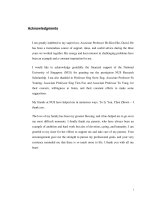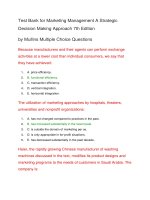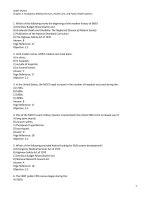Business statistics a decision making approach 6th edition ch16ppln
Bạn đang xem bản rút gọn của tài liệu. Xem và tải ngay bản đầy đủ của tài liệu tại đây (180.35 KB, 53 trang )
Business Statistics:
A Decision-Making Approach
6th Edition
Chapter 16
Introduction to
Nonparametric Statistics
Business Statistics: A Decision-Making Approach, 6e © 2010 PrenticeHall, Inc.
Chap 16-1
Chapter Goals
After completing this chapter, you should be able to:
Recognize when and how to use the Wilcoxon signed rank test for a population median
Recognize the situations for which the Wilcoxon signed rank test applies and be able to use it for decision-making
Know when and how to perform a Mann-Whitney U-test
Perform nonparametric analysis of variance using the Kruskal-Wallis one-way ANOVA
Business Statistics: A Decision-Making Approach, 6e © 2010 PrenticeHall, Inc.
Chap 16-2
Nonparametric Statistics
Nonparametric Statistics
Fewer restrictive assumptions about
data levels and underlying probability
distributions
Population distributions may be skewed
The level of data measurement may only
be ordinal or nominal
Business Statistics: A Decision-Making Approach, 6e © 2010 PrenticeHall, Inc.
Chap 16-3
Wilcoxon Signed Rank Test
Used to test a hypothesis about one
population median
the median is the midpoint of the distribution: 50%
below, 50% above
A hypothesized median is rejected if sample results vary too much from expectations
no highly restrictive assumptions about the shape of
the population distribution are needed
Business Statistics: A Decision-Making Approach, 6e © 2010 PrenticeHall, Inc.
Chap 16-4
The W Test Statistic
Performing the Wilcoxon Signed Rank Test
Calculate the test statistic W using these steps:
Step 1: collect sample data
Step 2: compute di = difference between each value and the hypothesized median
Step 3: convert di values to absolute differences
Business Statistics: A Decision-Making Approach, 6e © 2010 PrenticeHall, Inc.
Chap 16-5
The W Test Statistic
(continued)
Performing the Wilcoxon Signed Rank Test
Step 4: determine the ranks for each di value
eliminate zero di values
Lowest di value = 1
For ties, assign each the average rank of the
tied observations
Business Statistics: A Decision-Making Approach, 6e © 2010 PrenticeHall, Inc.
Chap 16-6
The W Test Statistic
(continued)
Performing the Wilcoxon Signed Rank Test
Step 5: Create R+ and R- columns
for data values greater than the hypothesized
median, put the rank in an R+ column
for data values less than the hypothesized
median, put the rank in an R- column
Business Statistics: A Decision-Making Approach, 6e © 2010 PrenticeHall, Inc.
Chap 16-7
The W Test Statistic
(continued)
Performing the Wilcoxon Signed Rank Test
Step 6: the test statistic W is the sum of the ranks in the R+ column
Test the hypothesis by comparing the calculated W to the critical value from the table in appendix P
Note that n = the number of non-zero di values
Business Statistics: A Decision-Making Approach, 6e © 2010 PrenticeHall, Inc.
Chap 16-8
Example
The median class size is claimed to be 40
Sample data for 8 classes is randomly obtained
Compare each value to the hypothesized median to find
difference
Class Difference
size = xi di = xi – 40
23
45
34
78
34
66
61
95
-17
5
-6
38
-6
26
21
55
Business Statistics: A Decision-Making Approach, 6e © 2010 PrenticeHall, Inc.
| di |
17
5
6
38
6
26
21
55
Chap 16-9
Example
(continued)
Rank the absolute differences:
tied
| di |
Rank
5
6
6
17
21
26
38
55
1
2.5
2.5
4
5
6
7
8
Business Statistics: A Decision-Making Approach, 6e © 2010 PrenticeHall, Inc.
Chap 16-10
Example
(continued)
Put ranks in R+ and R- columns
and find sums:
Class Difference
size = xi di = xi – 40
These three
are below
the claimed
median, the
others are
above
23
45
34
78
34
66
61
95
-17
5
-6
38
-6
26
21
55
Business Statistics: A Decision-Making Approach, 6e © 2010 PrenticeHall, Inc.
| di |
Rank
17
5
6
38
6
26
21
55
4
1
2.5
7
2.5
6
5
8
R+
R4
1
2.5
7
2.5
6
5
8
Σ = 27
Σ=9
Chap 16-11
Completing the Test
H0: Median = 40
HA: Median ≠ 40
Test at the α = .05 level:
This is a two-tailed test and n = 8, so find WL and WU in
appendix P: WL = 3 and WU = 33
The calculated test statistic is W = ΣR+ = 27
Business Statistics: A Decision-Making Approach, 6e © 2010 PrenticeHall, Inc.
Chap 16-12
Completing the Test
(continued)
H0: Median = 40
HA: Median ≠ 40
WL = 3 and WU = 33
W = ΣR+ = 27
reject H0
WL = 3
do not reject H0
WL < W < WU
WU = 33
reject H0
so do not reject H0
(there is not sufficient evidence to conclude that the
median class size is different than 40)
Business Statistics: A Decision-Making Approach, 6e © 2010 PrenticeHall, Inc.
Chap 16-13
If the Sample Size is Large
The W test statistic approaches a normal distribution as n increases
For n > 20, W can be approximated by
z=
n(n + 1)
W−
4
n(n + 1)(2n + 1)
24
where W = sum of the R+ ranks
d = number of non-zero di values
Business Statistics: A Decision-Making Approach, 6e © 2010 PrenticeHall, Inc.
Chap 16-14
Nonparametric Tests for Two
Population Centers
Nonparametric
Tests for Two
Population Centers
Mann-Whitney
U-test
Small
Samples
Large
Samples
Business Statistics: A Decision-Making Approach, 6e © 2010 PrenticeHall, Inc.
Wilcoxon
Matched-Pairs
Signed Rank Test
Small
Samples
Large
Samples
Chap 16-15
Mann-Whitney U-Test
Used to compare two samples from two populations
Assumptions:
The two samples are independent and random
The value measured is a continuous variable
The measurement scale used is at least ordinal
If they differ, the distributions of the two populations will
differ only with respect to the central location
Business Statistics: A Decision-Making Approach, 6e © 2010 PrenticeHall, Inc.
Chap 16-16
Mann-Whitney U-Test
(continued)
Consider two samples
combine into a singe list, but keep track of
which sample each value came from
rank the values in the combined list from low
to high
For ties, assign each the average rank of the tied values
separate back into two samples, each value
keeping its assigned ranking
sum the rankings for each sample
Business Statistics: A Decision-Making Approach, 6e © 2010 PrenticeHall, Inc.
Chap 16-17
Mann-Whitney U-Test
(continued)
If the sum of rankings from one sample differs enough from the sum of rankings from the other sample, we
conclude there is a difference in the population medians
Business Statistics: A Decision-Making Approach, 6e © 2010 PrenticeHall, Inc.
Chap 16-18
Mann-Whitney U-Test
(continued)
Mann-Whitney U-Statistics
n1 (n1 + 1)
U1 = n1n 2 +
− ∑ R1
2
n2 (n2 + 1)
U2 = n1n2 +
− ∑ R2
2
where:
n1 and n2 are the two sample sizes
∑R1 and ∑R2 = sum of ranks for samples 1 and 2
Business Statistics: A Decision-Making Approach, 6e © 2010 PrenticeHall, Inc.
Chap 16-19
Mann-Whitney U-Test
(continued)
Claim: Median class size for Math is larger
than the median class size for English
A random sample of 9 Math and 9 English
classes is selected (samples do not have to
be of equal size)
Rank the combined values and then split
them back into the separate samples
Business Statistics: A Decision-Making Approach, 6e © 2010 PrenticeHall, Inc.
Chap 16-20
Mann-Whitney U-Test
(continued)
Suppose the results are:
Class size (Math, M) Class size (English, E)
23
45
34
78
34
66
62
95
81
Business Statistics: A Decision-Making Approach, 6e © 2010 PrenticeHall, Inc.
30
47
18
34
44
61
54
28
40
Chap 16-21
Mann-Whitney U-Test
(continued)
Ranking for combined samples
tied
Size
Rank
Size
Rank
18
1
45
10
23
2
47
11
28
3
54
12
30
4
61
13
34
6
62
14
34
6
66
15
34
6
78
16
40
8
81
17
44
9
95
18
Business Statistics: A Decision-Making Approach, 6e © 2010 PrenticeHall, Inc.
Chap 16-22
Mann-Whitney U-Test
(continued)
Split back into the original samples:
Class size
(Math, M)
Rank
Class size
(English, E)
Rank
23
45
34
78
34
66
62
95
81
2
10
6
16
6
15
14
18
17
30
47
18
34
44
61
54
28
40
4
11
1
6
9
13
12
3
8
Σ = 104
Business Statistics: A Decision-Making Approach, 6e © 2010 PrenticeHall, Inc.
Σ = 67
Chap 16-23
Mann-Whitney U-Test
(continued)
Claim: Median class size for
Math is larger than the
median class size for English
Math:
H0: MedianM ≤ MedianE
HA: MedianM > MedianE
n1(n1 + 1)
(9)(10)
U1 = n1n2 +
− ∑ R1 = (9)(9) +
− 104 = 22
2
2
n2 (n2 + 1)
(9)(10)
− ∑ R 2 = (9)(9) +
− 67 = 59
English: U2 = n1n2 +
2
2
Note: U1 + U2 = n1n2
Business Statistics: A Decision-Making Approach, 6e © 2010 PrenticeHall, Inc.
Chap 16-24
Mann-Whitney U-Test
(continued)
The Mann-Whitney U tables in Appendices L and M give the lower tail of the U-distribution
For one-tailed tests like this one, check the alternative hypothesis to see if U 1 or U2 should be used as the test statistic
Since the alternative hypothesis indicates that population 1 (Math) has a higher median, use U 1 as the test statistic
Business Statistics: A Decision-Making Approach, 6e © 2010 PrenticeHall, Inc.
Chap 16-25









